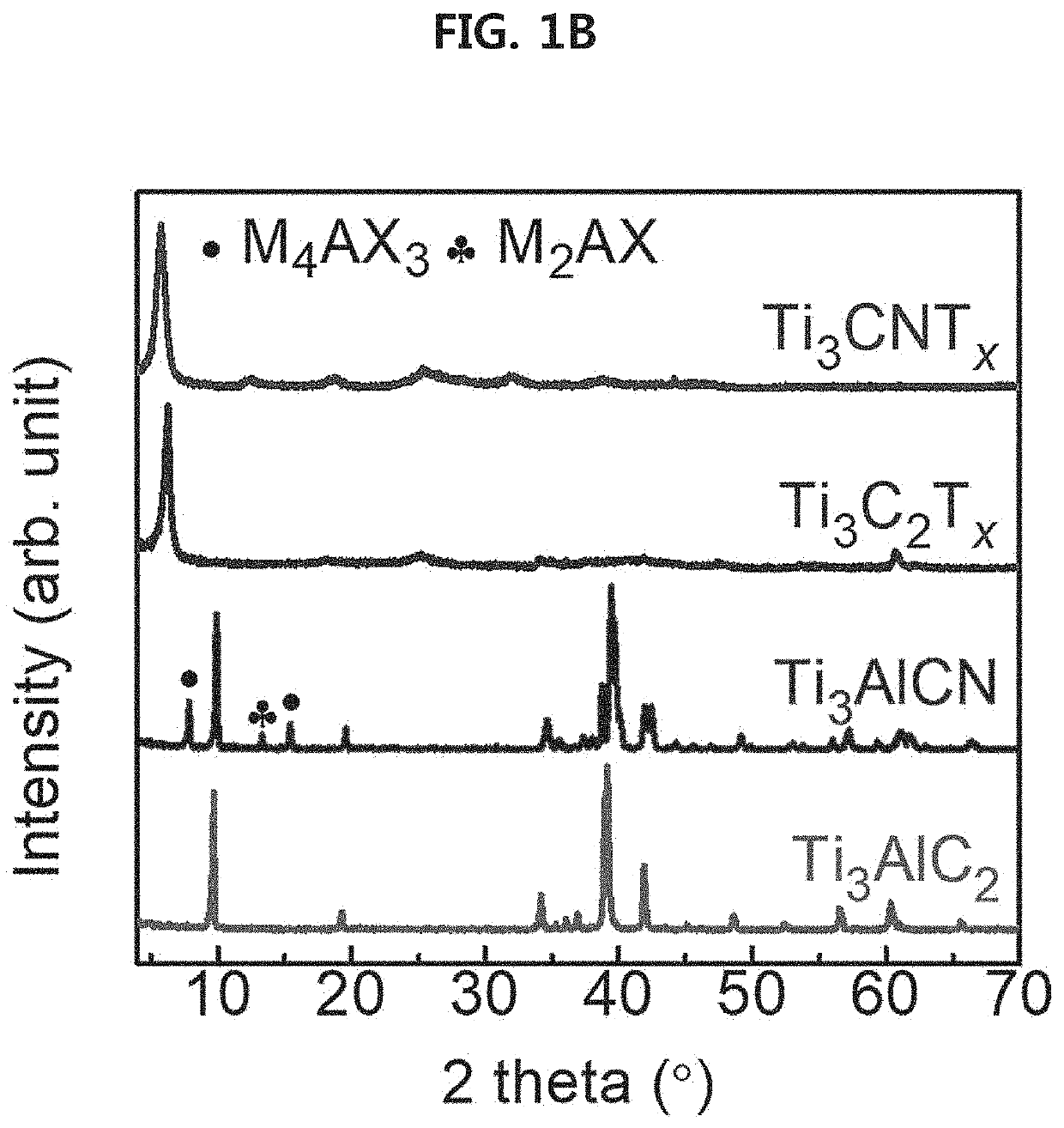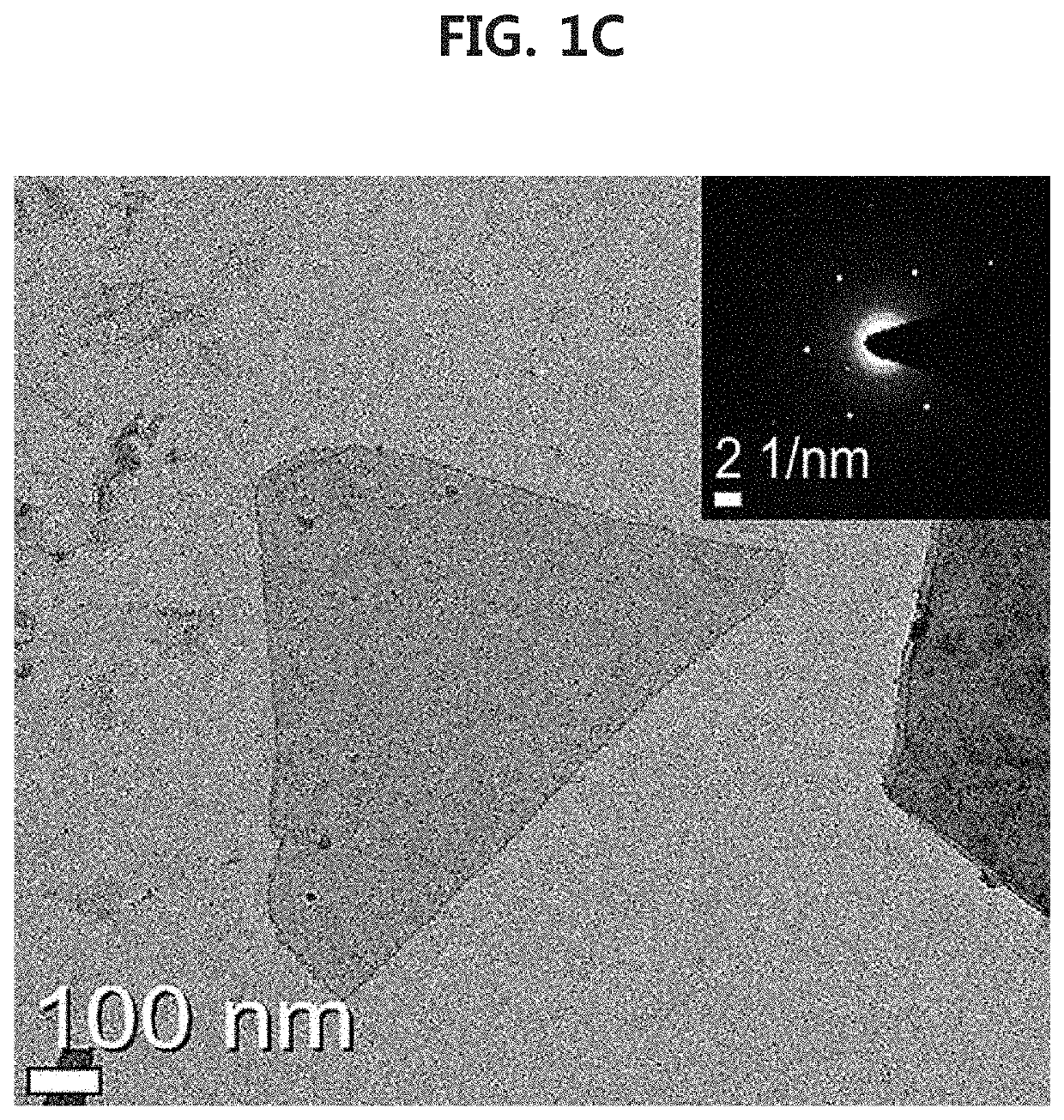Transition metal carbonitride mxene films for EMI shielding
a technology of transition metal carbonitride and mxene film, which is applied in the direction of coatings, nitrogen and non-metal compounds, chemical instruments and processes, etc., can solve the problems of inability to meet the requirements of a large-scale electronic device, affecting the performance of the device, and inevitably raising an electromagnetic interference (emi) issue, etc., to achieve the effect of ensuring the shielding effect, low weight and sufficient mechanical strength and flexibility
- Summary
- Abstract
- Description
- Claims
- Application Information
AI Technical Summary
Benefits of technology
Problems solved by technology
Method used
Image
Examples
example 1
and Methods
Example 1.1 Materials
[0095]Ti3AlCN MAX powder with a particle size of less than 38 μm was synthesized at the lab scale following Hantanasirisakul, K., et al., Effects of Synthesis and Processing on Optoelectronic Properties of Titanium Carbonitride MXene. Chemistry of Materials, 2019. 31: p. 2941-2951, and Ti3AlC2 MAX powder with a particle size of less than 38 μm was purchased from Carbon-Ukraine ltd. Lithium fluoride (LiF, 98.5%) and hydrochloric acid (HCl, 37%) were purchased from Alfa Aesar, and polypropylene membrane (Celgard, pore size 0.064 μm) was used to obtain MXene films via vacuum-assisted filtration.
Example 1.2 Synthesis of Ti3CNTx MXene
[0096]Ti3CNTx was synthesized from Ti3AlCN MAX phase. In this synthesis protocol, Ti3AlCN was used instead of Ti3AlC2. Briefly describing, 1 g of Ti3AlCN MAX was gradually added to a mixture of 20 mL of 9 M HCl and 1.6 g of LiF in a 100 mL polypropylene bottle with continuous stirring at room temperature for 24 hours. The obta...
example 1.6
Annealing of Spray-Coated MXene Films on a Glass Substrate
[0100]Micrometer-thick Ti3CNTx and Ti3C2Tx MXene films were spray-coated on a glass substrate and completely dried on a hot plate set to the temperature of 90° C. The spray-coated films were annealed to analyze the adhesive strength of the MXene films during heat treatment. In this instance, the spray-coated Ti3CNTx and Ti3C2Tx MXene films on the glass substrate were annealed at 350° C. for 6 hours.
example 2
Materials Characterization
Example 2.1 Characterization
[0101]The structure and morphology of pristine and heat-treated Ti3CNTx and Ti3C2Tx MXene films were investigated by a scanning electron microscope (SEM) (Inspect F50, FEI, USA) and a transmission electron microscope (TEM) (Tecnai F20 G2, FEI, at 200.0 kV voltage). The initial thickness measurements were performed using a highly accurate length gauge (with a tolerance factor of ±0.1 μm) of Heidenhain Instruments (Germany), and were verified using SEM.
[0102]A focused ion beam (FIB) (Nova 600 Nanolab, FEI Company, Netherland) was used to cut the cross-section of the films in order to analyze the cross-sectional morphology of the samples using high resolution TEM images and element mapping (high resolution TEM (HRTEM) Talos, FEI Company, F200X).
[0103]X-ray diffraction (XRD) patterns were obtained using a D8 diffractometer with Cu-Kα radiation (40 kV and 44 mA) at a 28 (theta) range of 4° to 70° with a scanning step of 0.02°, a step ...
PUM
| Property | Measurement | Unit |
|---|---|---|
| porosity | aaaaa | aaaaa |
| surface electrical conductivity | aaaaa | aaaaa |
| thickness | aaaaa | aaaaa |
Abstract
Description
Claims
Application Information
 Login to View More
Login to View More - R&D
- Intellectual Property
- Life Sciences
- Materials
- Tech Scout
- Unparalleled Data Quality
- Higher Quality Content
- 60% Fewer Hallucinations
Browse by: Latest US Patents, China's latest patents, Technical Efficacy Thesaurus, Application Domain, Technology Topic, Popular Technical Reports.
© 2025 PatSnap. All rights reserved.Legal|Privacy policy|Modern Slavery Act Transparency Statement|Sitemap|About US| Contact US: help@patsnap.com



